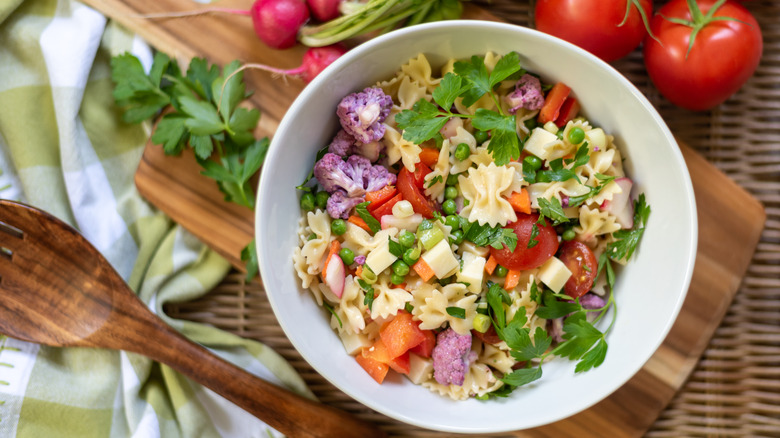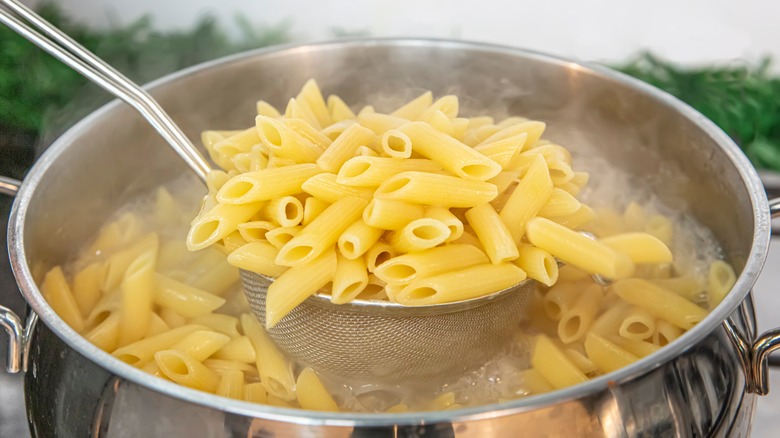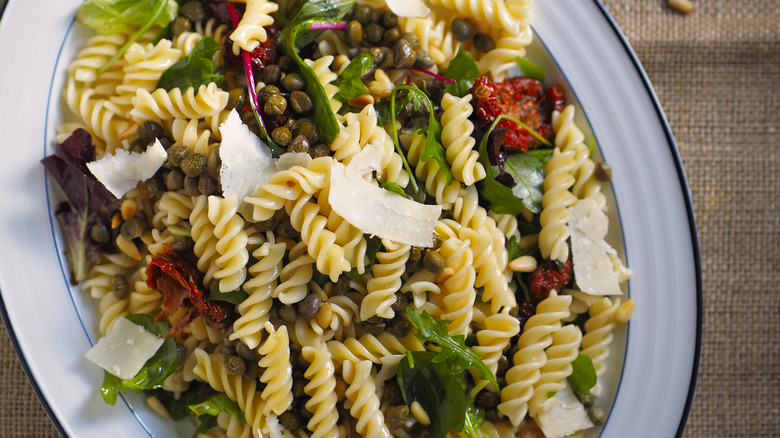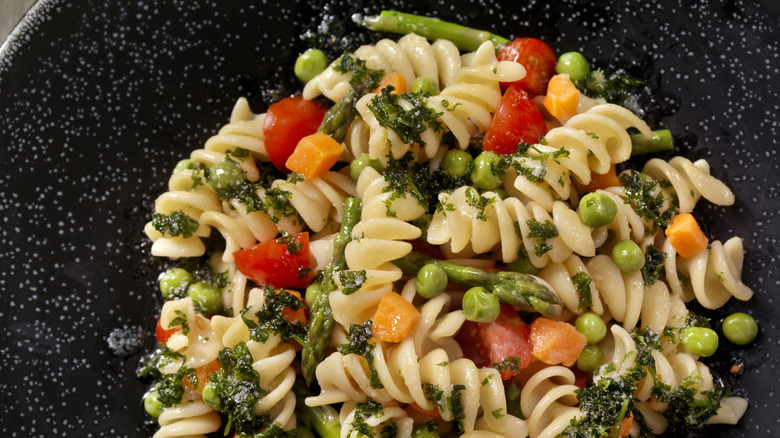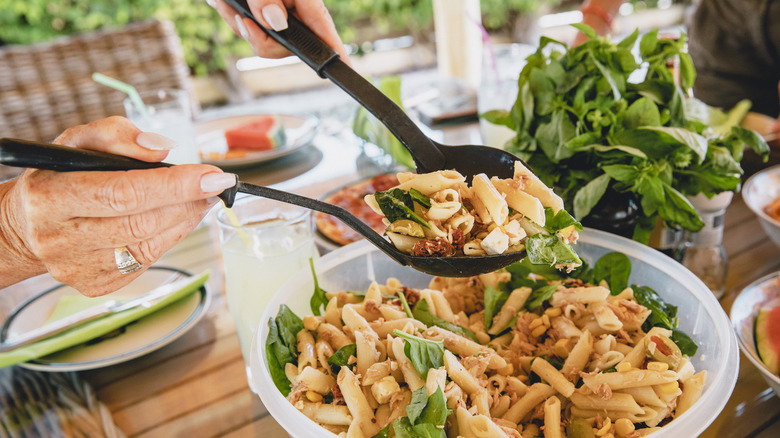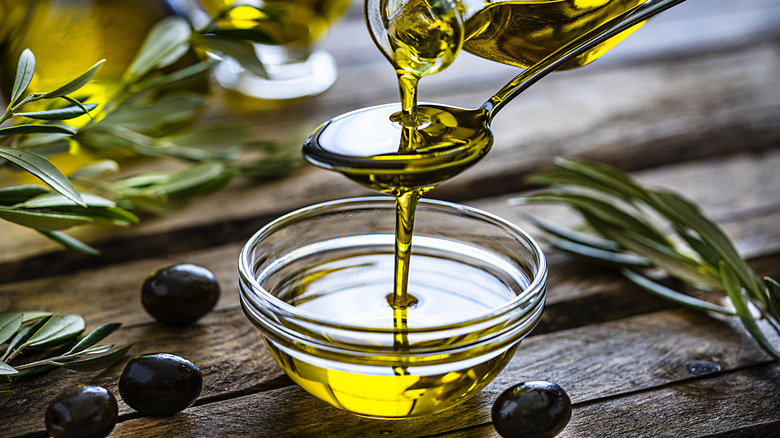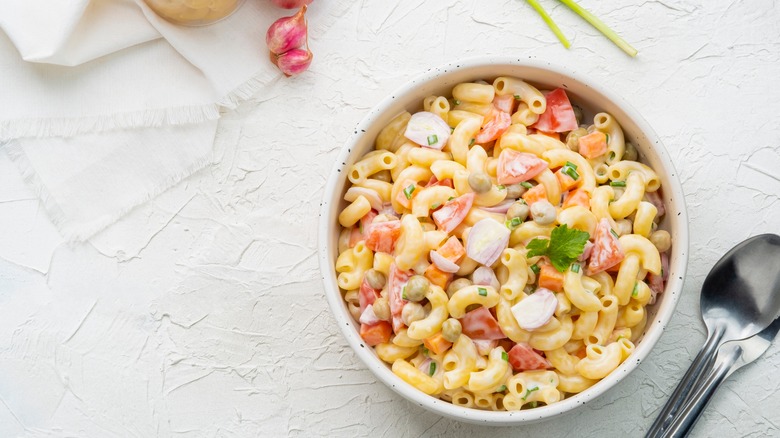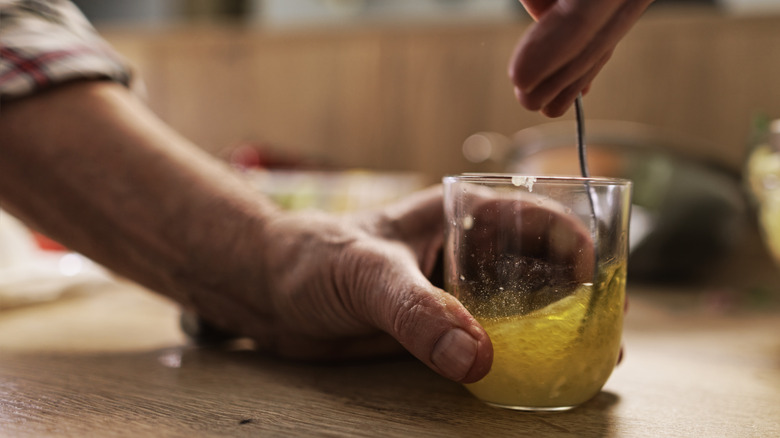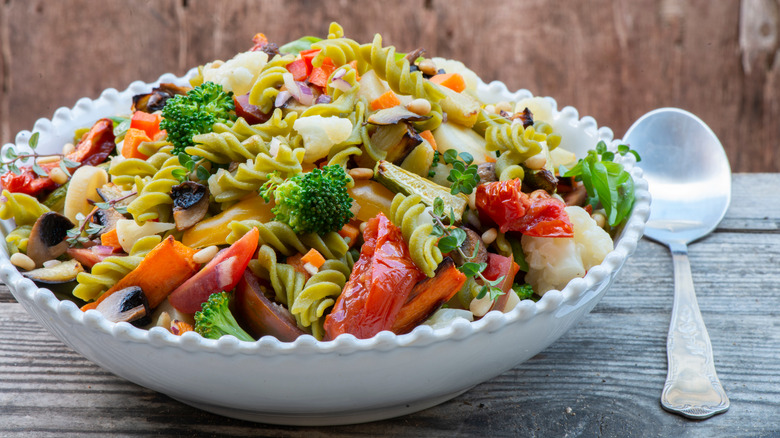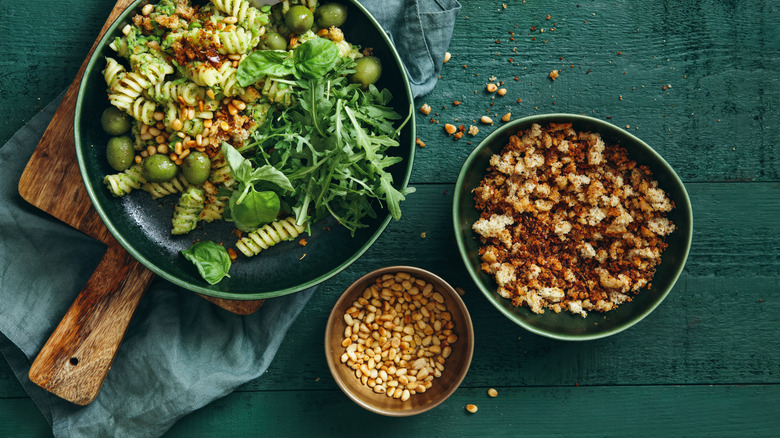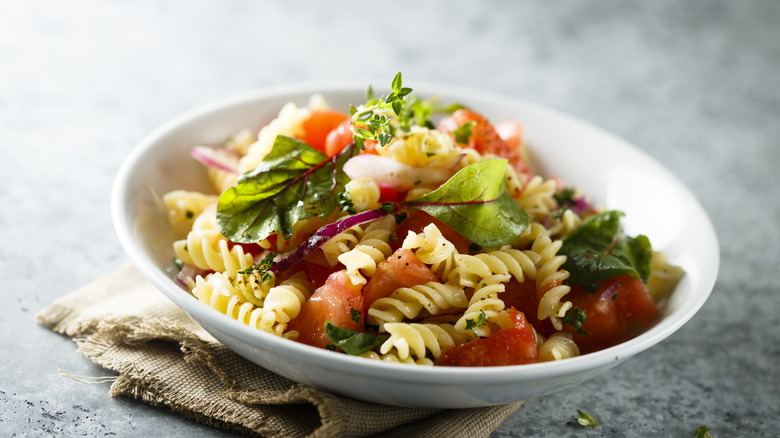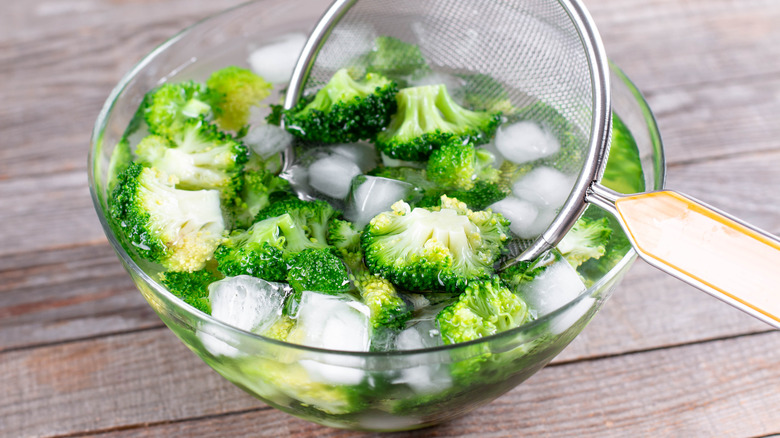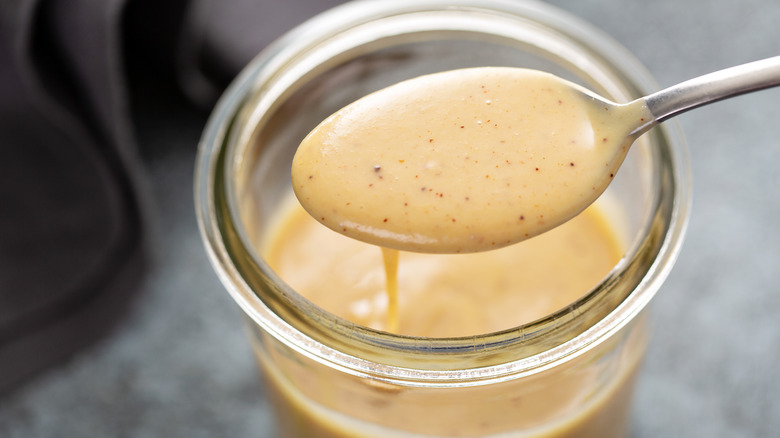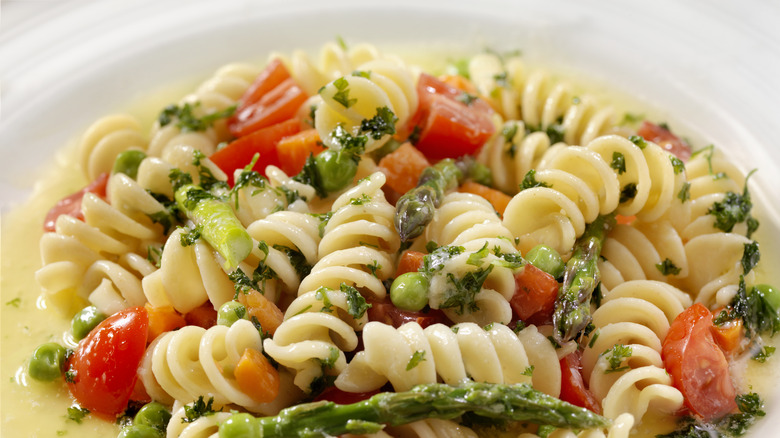15 Ways You're Ruining Pasta Salad
The second you get your first waft of freshly cut grass and barbecue smoke, you know summer's in full swing. Fresh strawberries, corn on the cob, and hot dogs are just around the corner, which means it's time you prepare your taste buds for a whole new cuisine. Out with the heavy and hot comfort foods, in with the fresh produce and light, refreshing fare. Luckily, we can adapt some of our favorite comfort food dishes to be enjoyed even in the dog days of summer, especially those we can't even fathom stowing away for a whole season. Pasta, in particular, although a year-round classic, can take a particularly summer-like form when it comes to pasta salad. Replace that hearty, simmering sauce with fresh dressings, herbs, vegetables, and cheese. When done right, pasta salad can make for an incredible main course or side. However, there are many ways you can ruin pasta salad, so it's important to stick to a few important key guidelines.
Ever had one of those bland, crunchy, or discombobulated bowls of pasta salad at a potluck? It happens all too often, and unfortunately, pasta salad can be tricky to make from scratch if you're not following a recipe. And while it's important to follow the major tips you need to make the ultimate pasta salad, it's also important to avoid frequently made mistakes. Here are the top slip-ups you can easily avoid when you're ready to dive into your pasta salad recipe.
1. Undercooking the pasta
When you're gearing up to make a big pot of pasta marinara, it's essential that you don't overcook those noodles. They should be al dente, and if they end up mushy, you may just be able to make out the sound of an ancient Italian chef rolling over in their grave. However, when making pasta for pasta salad, you'll have to toss aside anything you've ever learned about testing your pasta to see if it's done. In fact, you should be overcooking your pasta salad, and here's why.
When pasta is hot, it's nice and doughy, but when it cools it can dry out and become slightly crunchy. Ever tasted your cold pasta leftovers before reheating them? If you overcook your pasta, once it's chilled, it will even out to the perfect al dente-style tenderness you're used to. And when we say overcook, we don't mean obliterate the poor noodles into oblivion. Just cook them for a few more minutes than you typically would and strain them before they become mushy or begin to fall apart. This may go against everything you've learned about pasta making, but we can assure you that after being cooled, the pasta will be cooked to perfection.
2. Using the wrong pasta shapes
Although you can really make any pasta shape into pasta salad, there are certainly some that hold up better than others. For instance, while pappardelle or angel hair might be your personal favorites when it comes to the hot dish, they tend not to work so well in salad form. In fact, most long, thin, and sleek noodles like linguini, spaghetti, and fettuccine don't make the cut. And although they are classics, there are three reasons why we avoid these shapes in cold form.
The first reason is that pasta can become less malleable when cooled, so these long noodles have a tendency to break apart more easily. The second reason is that pasta salad is typically a serve-yourself dish presented in a large bowl. These noodle shapes hold up better when individually portioned, especially if you plan on evenly distributing the vegetables and other anterior ingredients. The third reason is that they don't cling to salad dressings quite as well as noodles with rivets.
Look for bite-sized pasta with lots of nooks and crannies to carry flavor. Try the absolute best pasta to use for pasta salad, fusilli, also known as corkscrew pasta. Not only will this shape cling to any salad dressing, no matter how thin, but can also harbor smaller ingredients like herbs, crumbled cheese, and minced vegetables. But don't limit yourself — try campanelle, cavatappi, farfalle, tortellini, and radiatori.
3. Avoiding a theme
There are plenty of recipes out there that encourage you to just throw together whatever you have in your refrigerator. And while sometimes the everything-but-the-kitchen-sink approach can produce a loaded and delicious dish, it's often a good idea to stick to a theme, especially when you're working in a new territory. This is the problem that many people run into with stir fries, casseroles, pizzas, and of course, pasta salads.
There are several ways to choose a theme. A simple option is to pick a region of the world and focus on ingredients that are popular and native to the area. For instance, try a Southwest pasta salad recipe containing peppers, onions, tomatoes, avocado, beans, and a creamy chipotle dressing. Travel to the other end of the world and experiment with Mediterranean flavors, like in a veggie antipasti Italian pasta salad recipe. Zero in on olives, pepperoncini, artichoke hearts, and mozzarella, and finish with an herby lemon and olive oil dressing.
Another method for choosing a theme is to concentrate on the seasonal produce. In the fall choose butternut squash, pecans, cranberries, and Brussels sprouts, finished with an apple cider and maple vinaigrette. In the summer, meanwhile, stick to fresh peas, basil, parsley, corn, and tomatoes, and finish with a refreshing lemon honey and herb dressing.
4. Skimping on the vegetables
If you're not a huge fan of salad, you may have opted for a potato or pasta salad as your side dish of choice. And while this eliminates the need for leafy greens in particular, it will be difficult to escape from vegetables altogether. This is because vegetables do more than just add nutrition to your pasta salad, they also add aesthetic appeal, variance of texture, and of course, flavor. In fact, some of the best mix-ins to upgrade pasta salad are vegetables.
For a juicy, crunchy, and sweet addition, try dicing red and yellow peppers. Sliced kalamata olives, as well as capers, can add a punch of saltiness. Sliced cherry tomatoes are wanter-dense and can be quite juicy, especially when blanched. Peas, both cooked and raw, are sweet, starchy, and universally loved. Choose an aromatic like raw or cooked sweet onion, or raw or pickled red onion. Fresh corn on the cob is a summer classic and can add a juicy pop of texture and sugar. Blanched broccoli does a great job of clinging to dressing and helps carry flavor throughout the dish. The options are endless, so don't skimp on the vegetables when planning out your salad.
5. Forgetting to add herbs and spices
When cooking any pasta dish, herbs and spices are essential. Whether they are incorporated into your sauce or dressing, or sprinkled on top as a garnish there's no getting around their importance. Your basic mayo-based pasta salad with peas and shredded carrots may get the job done, but certainly won't be winning any prizes in the flavor department.
If you're making your own dressing from scratch, be sure to add minced fresh herbs or dried herbs. If you use dried herbs and spices, be sure to make your dressing beforehand to give them a chance to infuse the rest of the dressing with flavor before it's added to the pasta. Don't forget to mix in fresh herbs like basil and parsley, minced or chopped slightly to help distribute flavor. If your pasta salad has a Southwestern, South American, or Southeast Asian theme, consider including cilantro. Any Mediterranean-style pasta salad can be enhanced by fresh oregano. Just brush up on the common types of herbs and how to use them before incorporating them into your dish.
6. Adding a low-quality oil
When it comes to any sort of salad, quality olive oil is absolutely key. And while you may not want to use an expensive bottle to sauté your vegetables or marinate your meat, it's a good idea to keep some on hand for garnishing dishes, and for dressings. It may seem like the difference between olive oil, and a high-quality extra virgin olive oil is minimal, both the mouthfeel and flavors are quite noticeable.
Adding a low-quality oil to your pasta salad will simply add an element of fat. For flavor, turn to one of the best finishing olive oil brands, or a fresh, imported bottle of EVOO. Do what feels comfortable for your budget, but be sure to pay attention to the expiration date. A fresh bottle of EVOO should have a rich mouthfeel, with floral, fruity undertones. However, there is quite a range, as with wine, from complex to delicate, so choose according to your personal preference.
7. Melting your mayo
There are two kinds of basic pasta salads out there: those made with mayonnaise-based dressings and those made with olive oil-based dressings. While one is creamy, the other tends to be lighter and more tangy. Both can contain herbs, spices, vinegar, and other flavorful elements, but they should be treated differently during the preparation process.
If you opt for a mayonnaise base, then it's important to cool your cooked pasta before adding the dressing. This is because mayonnaise contains whipped oil, which can melt when heated up. Think about the times you've used mayo on the outside of the bread of your grilled cheese. It melts and aids in that wonderful crunch of the toasted bread, but that fluffy white texture is gone. Therefore, if the goal is to make a creamy dressing, then you'll want that whipped oil to stay intact. The best way to cool pasta for pasta salad is not to run it under cold water, but to transfer it to a sheet tray. After it's cooled for about 30 minutes, transfer it to the refrigerator.
8. Adding your vinegarette too late
If you're opting for an oil-based dressing, like a vinaigrette, for your pasta salad, then there are a few key tips to follow to better help your pasta to absorb flavor. If you add your vinaigrette after the pasta has fully cooled, then it will be less likely to absorb the sauce. The same goes for pasta that's been rinsed after being cooked. Instead, it's best to dress pasta salad while it's still warm, with any oil-based dressing.
In fact, you can add the dressing stages. Add about 60% of your salad dressing right when the pasta comes out of the strainer. At this stage, it will still be quite starchy and will cling to the dressing and absorb it. Right before serving your salad, add the rest of the dressing. This will ensure that your other ingredients are able to tangle with the flavors of the sauce and that it will be the right consistency.
9. Not including enough acid
Ever have a bland pasta salad? Nobody is expecting pasta to overwhelm your tastebuds since that's the job of the dressing or sauce. One way to boost the flavor is by increasing the amount of acid added to the mix. Seriously, this updated vinaigrette formula takes salad to the next level.
Choose your acid wisely. Citrus fruit like lemon or lime can be refreshing options, while vinegar can be a bit sweeter in some cases. Apple cider vinegar and balsamic tend to work well in most dressings, while champagne vinegar and red wine vinegar tend to have a crisper and lighter mouthfeel. Whatever your typical ratio is of acid to oil, try increasing the amount of acid added. Especially when mixed with something as mild as pasta, it's nice to enhance the use of both vinegar and other strong flavors like aromatics. Add it little by little to ensure you don't overwhelm the dish.
10. Cutting your vegetables too large
Yes, vegetables can be quite lovely. Broccoli florets, whole cherry tomatoes, cucumber slices, and chunks of carrots add color, textural contrast, and of course, flavor. But, you certainly don't want to be left chewing and chewing one particular chunk of vegetables instead of enjoying the combination of all. That's why the way you chop your vegetables for tuna salad, potato salad, and pasta salad really matters. The goal is to have a forkful of flavor, not just one large vegetable.
Each vegetable should be made bite-sized or smaller. Ideally, everything would be somewhere between the size of a kernel of corn, and half of a cherry tomato. The vegetables should not exceed the size of your pasta, and ideally would be smaller. Variation is key. If you have a few large broccoli florets in the salad, add some peas, shredded carrots, or diced red onion. This way, your dish isn't completely uniform, and you're able to get a variety of veggies on your fork all at once while still leaving room for a noodle or two.
11. Not varying texture enough
There's nothing worse than a big bowl of mushy, boring pasta salad, loaded with roasted red peppers, caramelized onions, blanched cherry tomatoes, and marinated olives. While those flavors could taste absolutely incredible together, it lacks a variety of texture. Your pasta should be al dente once cooled, and your anterior ingredients should complement and contrast that texture. And when it comes to diversifying texture, there are plenty of options on the table.
Think about all the crunchy additions to summer salads you've used in the past. Raw vegetables tend to have a pleasing crunch to them. Try corn, raw peas, diced red pepper, diced red onion, diced cucumber, and grated carrots. In addition, nuts and seeds differ greatly from both pasta and vegetables and can be added in abundance. Pine nuts and walnuts can melt in your mouth, while almond slivers are typically quite crunchy. Chewy meats like pancetta or bacon can bring a whole new mouthfeel.
12. Failing to think outside of the box
Yes, a four-ingredient pasta salad recipe may be quite tempting when it comes to budgeting time, but it isn't always the best option in regards to flavor. Stick to basics is easy enough, but the basics aren't what makes a recipe crave-worthy. You don't want to go overboard when adding ingredients, but as long as their flavor profiles line up, it's always a good idea to experiment. If you're not 100% sure about your decision, take a spoonful or two aside, add your punchy ingredient, and taste test until the cows come home.
Get creative with ingredients like capers, or leftover pickle juice. Both are incredibly flavorful and add elements of saltiness. Fruits like mango or pineapple have been known to sneak their way into pasta salad dishes, as well as craisins, and grapes. Try pickled vegetables like chopped pickled asparagus, pickled beets, and pickled red onion.
13. Only adding raw ingredients
Raw vegetables tend to have incredible texture to them. They are crunchy, juicy, and vary beautifully. However, it's not necessary to include only raw vegetables in your pasta salad, as your dish can greatly benefit from roasted, blanched, and even caramelized ingredients.
Even if you're looking to achieve a crunchy textured pasta salad, you can certainly still add cooked ingredients — just be sure to blanch them instead of steam or sauté them. Try blanched broccoli florets, blanched cherry tomatoes, and blanched peas. Others benefit from slow cooking or roasting, like caramelized onions or shallots, roasted red pepper, or roasted Brussels sprouts. Add both raw and cooked vegetables to increase variation, but keep in mind that even a quick blanching can help your veggie to become more palatable and will help to bring out the natural flavors of the vegetables. In addition, it will give your jaw a break from mowing down on tougher veggies like broccoli and carrots.
14. Always using store bought dressing
While store-bought dressing can make for a quick pasta salad, consider making your own dressing with fresh ingredients. If you know what you're doing, or follow a formula or recipe, it can make a huge difference. In addition, you have more control over the balance of flavor going into your salad. There are many types of salad dressings out there, so it's important to focus on the style you're going for as you choose ingredients. Your first decision is whether to make an oil-based, or mayonnaise-based dressing.
If you choose to go with an oil-based dressing like a vinaigrette, consider varying from the mainstream recipes and try adding the ingredient that will change your salad dressing forever: walnut oil. Although extra virgin olive oil is a classic, walnut oil has a luscious flavor, with a subtle hint of bitterness, similar to that of walnuts. Add fresh herbs and spices. This is your pass to go overboard on the garlic (like there is such a thing). Flex your creativity by making dressing from scratch.
15. Overdressing the salad
There is quite a bit of wiggle room when it comes to the quantity of salad dressing you can add to pasta salad, and this is because your noodles will absorb quite a bit of it. In an ideal world, your noodles would be coated evenly with the flavorful dressing, as well as your vegetables, meats, and cheeses. The bottom of your bowl would have just a few tablespoons of excess dressing, and it wouldn't overpower the natural flavors of the mix–in ingredients. Overdressing a pasta salad can lead to mushy noodles and a sloppy mess, and underdressing can make it end up feeling starchy and dry with a lack of flavor.
The ratio tip you need for a better balance pasta salad is to add one cup of dressing for each pound of pasta used. You can always add more if necessary. If you have about double the amount of veggies than you do noodles, this ratio should work out wonderfully, leaving your dish with just enough of a juicy kick, and a balanced mouthfeel.
